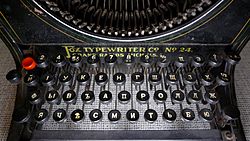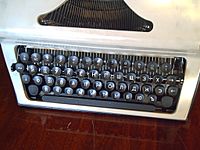Numero sign facts for kids
Quick facts for kids № |
|
|---|---|
|
Numero sign
|
|
The numero sign or numero symbol, № (also represented as Nº, No, No./no. (US English), or No/no (UK English); plural Nos./nos. (US English) or Nos/nos (UK English)), is a typographic abbreviation of the word number(s) indicating ordinal numeration, especially in names and titles. For example, with the numero sign, the written long-form of the address "Number 22 Acacia Avenue" is shortened to "№ 22 Acacia Avenue", yet both forms are spoken long.
Typographically, the numero sign combines the uppercase Latin letter N with a usually superscript lowercase letter o, sometimes underlined, resembling the masculine ordinal indicator.
The Oxford English Dictionary derives the numero sign from Latin numero, the ablative form of numerus ("number", with the ablative denotations of "by the number, with the number"). In Romance languages, the numero sign is understood as an abbreviation of the word for "number", e.g. Italian numero, French numéro, and Portuguese and Spanish número.
Contents
Usages
The numero sign, despite its widespread usage internationally, is not a standard alphabetic symbol in virtually any European language.
English
In English, the abbreviation "No." of "numero" is often used in place of the word "number". In American English, the hash or pound (#) is used as a prefix to designate numbers and at the end of a number to designate pounds of weight in some publications. In online usage, the hash may cause complications because of its usage for hashtags and HTML anchors, a complication not present with the numero sign (thus the numero sign can be used in places the hash cannot).
French
The numero symbol is not in common use in France and does not appear on a standard AZERTY keyboard. Instead, the French Imprimerie nationale recommends the use of the form "no" (an "n" followed by a superscript lowercase "o"). The plural form "nos" can also be used. In practice, the "o" is often replaced by the degree symbol (°), which is visually similar to the superscript "o" and is easily accessible on an AZERTY keyboard.
Spanish
The numero sign is not typically used in Iberian Spanish, and it is not present on standard keyboard layouts. According to the Real Academia Española and the Fundéu BBVA, the word número (number) is abbreviated per the Spanish typographic convention of letras voladas ("flying letters"). The first letter(s) of the word to be abbreviated are followed by a period; then, the final letter(s) of the word are written as lowercase superscripts. This gives the abbreviations n.o (singular) and n.os (plural). The abbreviation "no." is not used, because it might be mistaken for the Spanish word no (no, not). Furthermore, nro. and núm. are also acceptable abbreviations for número. The numero sign either as a one-character symbol (№) or composed of the letter N plus the superscript "o" character (sometimes underlined or substituted by º) is common in Latin America, where the interpolated period is sometimes not used in abbreviations.
Italian
The sign is usually replaced with the abbreviations "n." or "nº", the latter using an ordinal indicator, rather than a superscript 'O'. Similar superscript is also used for primo 1º and prima 1ª, secondo 2º and seconda 2ª, etc.
Russian
Although the letter "N" is not in the Cyrillic alphabet, the numero sign (№) is typeset in Russian publishing, and is available on Russian computer and typewriter keyboards.
-
PC keyboard with Russian layout.
№ sign can be seen on the ‘3’ key.
The № sign is sometimes used in Russia in medical prescriptions as an abbreviation for the Latin word numero to denote the number of prescribed dosages (for example, tablets or capsules), and on the price tags in drugstores and pharmacy websites to indicate number of unit doses in drug packages, although the standard abbreviation for use in prescriptions is N..
Philippines
Because of more than three centuries of Spanish colonisation, the word número is found in almost all Philippine languages. 'No.' is its common notation in local languages as well as English.
Indonesian and Malaysian
"Nomor" in Indonesian and "nombor" in Malaysian; therefore "No." is commonly used as an abbreviation with standard spelling and full stop.
Nr.
In some languages, Nr., nr., nr or NR is used instead, reflecting the abbreviation of the language's word for 'number'. German Nummer is represented this way, and this language capitalises all nouns and abbreviations of nouns. Lithuanian uses it as well, and it is usually capitalised in bureaucratic contexts, especially with the meaning 'reference number' (such as sutarties Nr., 'contract No.') but in other contexts it follows the usual sentence capitalisation (such as tel. nr., abbreviation for telefono numeris, 'telephone number'). It is most commonly lowercase in other languages, such as Dutch, Danish, Norwegian, Polish, Romanian, Estonian and Swedish. Some languages, such as Polish, omit the dot in abbreviations, if the last letter of the original word is present in the abbreviation.
Typing the symbol
On typewriters and computers that do not support this symbol, it is acceptable and commonplace to replace it with the trigraph "No." (letter "N", letter "o", and a period (full stop)).
On typewriters and computers that support the degree symbol or (preferably) masculine ordinal indicator, a digraph starting with "N", such as "N°" or "Nº", may suffice as a substitute for the numero sign, but only if it is to be presented exclusively within visual media, in a typeface and sizing that results in a passable approximation of the numero sign. Such digraphs are inappropriate for representing the numero sign in computer data, in general.
On Russian computer keyboard layout, the № character is available and often located on the 3 key.
In Mac OS X, the character can be typed using "U.S. Extended" and "Irish Extended" keyboard layouts by typing Shift. As of macOS 10.13, this combination does not yield the numero symbol when "U.S." or "U.S. International" is chosen. It will only yield the numero symbol when "ABC – Extended" is chosen as the input keyboard.
In X11 systems with a compose key, the character can be typed using Compose, Shift, O. Alternatively standard XIM style can be used: Ctrl + Shift + u, 2, 1, 1, 6, Enter.
In Microsoft Windows and HTML in general, the numero sign can be entered by the Unicode input methods № or №.
Images for kids





